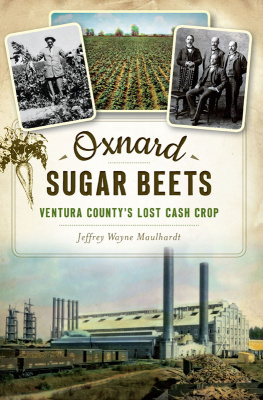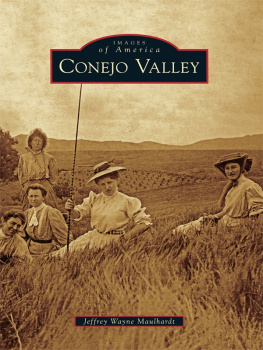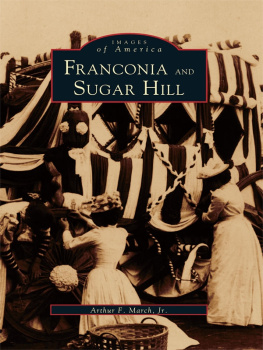

Published by The History Press
Charleston, SC
www.historypress.net
Copyright 2016 by Jeffrey Wayne Maulhardt
All rights reserved
Front cover, clockwise from top left: Fred Noble, sugar beet field, Oxnard brothers, Oxnard Sugar Factory.
First published 2016
e-book edition 2016
ISBN 978.1.43965.829.1
Library of Congress Control Number: 2016941442
print edition ISBN 978.1.46713.679.2
Notice: The information in this book is true and complete to the best of our knowledge. It is offered without guarantee on the part of the author or The History Press. The author and The History Press disclaim all liability in connection with the use of this book.
All rights reserved. No part of this book may be reproduced or transmitted in any form whatsoever without prior written permission from the publisher except in the case of brief quotations embodied in critical articles and reviews.
To my group of history supporters and local historians who have supported me with information, leads and encouragement in this project and in all my history projects: Frank Naumann, Chuck Covarrubias, Jim Gill, Wayne Huff and my wife, Debbie Maulhardt
ACKNOWLEDGEMENTS
Thanks to the many people who have helped me over the years, collecting the pictures, stories and information used for this book. My great-uncle and aunt, Richard and Ruth Maulhardt, were the first to guide and educate me over twenty-five years ago. All of my extended aunts and uncles and distant cousins from the Maulhardt and Borchard families have also been generous with their time and support.
Additionally, I want to acknowledge the descendants of the Oxnard family, starting with James and Thornton Oxnard, who allowed me access to their family archives. More recently, Tom Oxnard came to visit Oxnard, and he, too, shared his stories and articles.
INTRODUCTION
The sugar beet was the crop that transformed the agriculture of Ventura County from a break-even venture to a lucrative cash crop for the farmers. Previously, cattle and sheep grazing had failed for many due to reoccurring drought years. Dry farming crops like barley, wheat and alfalfa were a safe investment, but profits were low, and as in the case of livestock, vast acreage was needed in order to turn a profit. Farmers experimented with other crops such as potatoes and lima beans, and while lima beans thrived along the coastal plain, the big cash crop was still elusive to the early farmers. Drilling for water wells was expensive and thus needed a crop that would guarantee a profit. Along came sugar beets, and once it was established that they could thrive in the soils of Ventura County, land values went up and a new population was needed to service the crop.
This is the story of how sugar beets came to the United States and made their way west to Ventura County. Also told is the history of the Oxnard family and how they developed the beet sugar industry as an alternative to cane sugar, thus making sugar one of the countys leading commodities.
Finally, this is about the many people who had a hand in the creation of a city that was named for the family who brought a factory to Ventura County.
For the city of Oxnard, the introduction of sugar beets created a home for many immigrant groups who have contributed to the agricultural industry. While sugar beets have long since grown in the alluvial soils of the Oxnard plain, their introduction to the community laid the foundation for the largest city in Ventura County. Many cash crops have followed the sugar beet, as farmers continue their search to find a way to make the most of the areas rich soil.

The American Beet Factory was located near Wooley Road and Oxnard Boulevard and was, for a short time, listed as the largest sugar refinery in the world. Authors collection.
EARLY AGRICULTURE
Commercial agriculture in Ventura County did not begin until the late 1860s. The Chumash provided the backbone during the mission period and into the rancho expansion time. The rancho that became Oxnard, Hueneme and parts of Camarillo was El Rio de Santa Clara o la Colonia, translated as the Colony by the Santa Clara River. It was forty-four thousand acres that were granted to eight soldiers from the presidio in Santa Barbara after 1837. They included Rafael Gonzalez, his brother Leandro, Valentin Cota, Salvador Valenzuela, Jose Maria Valenzuela, Vicente Pico, Rafael Valdez and Vicente Feliz. Few of the petitioners for the rancho settled on the remote section of land that was cut off by the Santa Clara River to the north, the Pacific Ocean to the west and the Santa Monica Mountains to the south. After years of litigation, the Gonzales family ran cattle on their portion near the river bottom. By the 1850s, the sparsely populated ranchos had survived through hospitality, trade and contributions from the native people.
Agriculture was still a personal endeavor in the area. The cattle industry lived and died with the varying levels of precipitation, and the final blow came during the drought years of 186364. Thousands of cattle perished due to a lack of grasslands. The Ventura Signal wrote in an 1872 article that sixty thousand head of cattle died, and many more were slaughtered. Many of the original land grantees were forced to sell the lands they had originally retained when California joined the Union in 1850. Squatters began looking for government land to homestead. Thomas Scott purchased many of the ranchos in anticipation of a thriving oil industry after he became aware of some reports from Benjamin Silliman following a visit to Ojai and the Ventura area in 1864, during which he witnessed rivers of oil. However, reaching the buried reserves proved frustrating to several supervisors, including Thomas Bard, who came to Ventura from Pennsylvania in 1865. After nearly two years of little progress in drilling for the big payday, Bard was ready to return to Pennsylvania and even sent a rider to Los Angeles with a telegram of resignation on December 8, 1866. His resignation would take effect on January 10, 1867. However, Scott did not acknowledge Bards letter, and Bard continued with his oil duties through February.

Early map of El Rio de Santa Clara o la Colonia that shows the location of the Gonzalez corral, as well as the seventeen thousand acres of disputed land that were later settled in favor of Thomas Bard. Authors collection.

This lady with a guitar may be a descendant of the Gonzalez family, the original grantees of the El Rio de Santa Clara o la Colonia. Several of the Gonzalez family members were musicians. Courtesy of Paula Eastwood, descendant of the Gonzalez family.
In March 1867, something occurred that changed the direction of commerce for many years to come. German-born Christian Borchard traveled to the gold fields of Northern California before settling in the San Joaquin Valley to farm and raise stock. After the floods of 1866 wiped out his livelihood, he traveled south and ended up on the south side of the Santa Clara River. He and his son John Edward Borchard planted thirty acres of barley and thirty acres of wheat, only to realize the wheat was susceptible to rust while the barley flourished. His initial crop set the stage for the evolution of the land and the growth of agriculture on what would become the Oxnard Plain.
Next page













